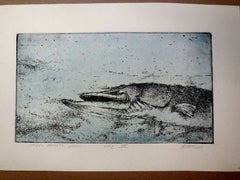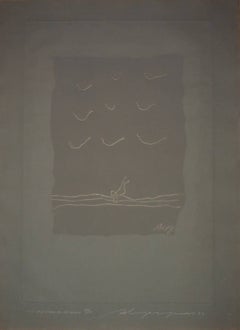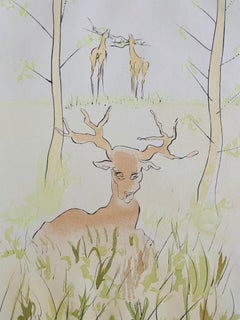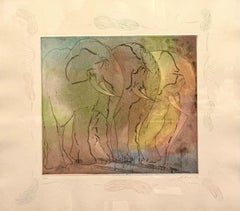Want more images or videos?
Request additional images or videos from the seller
1 of 5
Robert A. BirmelinPike III
$450List Price
About the Item
- Creator:Robert A. Birmelin (1933-2003, American)
- Dimensions:Height: 9 in (22.86 cm)Width: 13.63 in (34.63 cm)
- Medium:
- Movement & Style:
- Period:
- Condition:
- Gallery Location:Surfside, FL
- Reference Number:1stDibs: LU38210570242
About the Seller
4.9
Platinum Seller
Premium sellers with a 4.7+ rating and 24-hour response times
Established in 1995
1stDibs seller since 2014
1,810 sales on 1stDibs
Typical response time: 1 hour
Authenticity Guarantee
In the unlikely event there’s an issue with an item’s authenticity, contact us within 1 year for a full refund. DetailsMoney-Back Guarantee
If your item is not as described, is damaged in transit, or does not arrive, contact us within 7 days for a full refund. Details24-Hour Cancellation
You have a 24-hour grace period in which to reconsider your purchase, with no questions asked.Vetted Professional Sellers
Our world-class sellers must adhere to strict standards for service and quality, maintaining the integrity of our listings.Price-Match Guarantee
If you find that a seller listed the same item for a lower price elsewhere, we’ll match it.Trusted Global Delivery
Our best-in-class carrier network provides specialized shipping options worldwide, including custom delivery.You May Also Like
Resting The Horses
By Olaf Wieghorst
Located in New York, NY
Etching, 1937. Signed by the artist and dated in pencil lower right margin.
A scarce etching by this important American western artist.
Category
1930s American Realist Animal Prints
Materials
Etching
A Burro Train, New Mexico
By Peter Moran
Located in Middletown, NY
Etching with aquatint on heavy laid paper, 7 x 9 1/4 inches (172 x 233 mm), full margins. Signed in the plate, lower right image area. Minor corner loss, top right, and a 1/4 inch ed...
Category
Late 19th Century American Realist Animal Prints
Materials
Laid Paper, Etching
Shattered Silence, American Western Art Etching by Noel Daggett
By Noel Daggett
Located in Long Island City, NY
Noel Daggett, American (1925 - 2005) - Shattered Silence, Year: Circa 1980, Medium: Etching with Chine Colle, signed and numbered in pencil, Edition: 8/40, Size: 22 x 29 in. (55...
Category
1980s American Realist Animal Prints
Materials
Etching
JACK SNIPE
By Roland Clark
Located in Portland, ME
Clark, Roland (American 1874-1957). JACK SNIPE. Etching, 1928. Edition of 70. Signed in pencil. 8 1/2 x 12 inches. In excellent condition.
Category
1920s American Realist Animal Prints
Materials
Etching
THREE'S A CROWD
By Marguerite Kirmse
Located in Santa Monica, CA
MARGUERITE KIRMSE (English/American 1885-1954)
THREE’S A CROWD, c 1930
Etching, signed and titled in pencil. Plate 6 3/8 x 9 ¾ inches. Full sheet with edges on all sides. Sheet 10 5/8 x 13 5/8 inches. In good condition, save for old tape on sheet edges verso, showing through to recto. A hint of a mat line below the signature
Kirmse is considered to be one of the most important etchers of Dogs.
Sheet with even white tone - photos show oblique shadows
From Wikipedia:
Marguerite first trained as a harpist at the Royal Academy of Music but spent much of her spare time drawing animals. She went to the United States in 1910 on holiday with friends but stayed there.[4] She was not successful in advancing her musical career and focused her attention increasingly on her animal drawing, which she developed by frequent sketching trips to the Bronx Zoo.[5]
In 1921 she started producing etchings of dogs...
Category
1930s American Realist Animal Prints
Materials
Etching
20th century drypoint etching figurative animal print black and white signed
By John Edward Costigan
Located in Milwaukee, WI
"Boy With Cows" is an original drypoint etching by John Edward Costigan. It depicts a young boy with three cows standing in a watering hole. The artist si...
Category
1930s American Realist Figurative Prints
Materials
Drypoint, Etching
A Burro Train, New Mexico
By Peter Moran
Located in San Francisco, CA
This artwork titled "A Burro Train, New Mexico" 1880 is an original etching on Laid paper by noted British/American artist Peter Moran, 1841-1914. It is signed in the plate as issue. The plate mark (Image) size is 9.15 x 6.5 inches, framed size is 14.75 x 18.75 inches. It is framed in a wooden silver frame, with light grey matting. It is in excellent condition, especially considering the age. I like to mention that example of this particular etching is held in the following museums, including, The Toledo Museum Of Art, Toledo, The British Museum, London and The Smithsonian Museum Of Art, Washington D.C. It was also illustrated in American Art Review, volume #2 1881, page 163.
About the artist:
The younger brother of Thomas Moran, Peter Moran was a painter-etcher best known for his Romantic sensibility and landscape compositions incorporating animals. The Moran family immigrated to the United States from England in 1844, when Peter was three. He began his artistic career as an apprentice to a lithographic firm and eventually studied painting with his brothers Edward and Thomas. He was influenced by the animal paintings of Rosa Bonheur and Constant Troyon and visited England in 1863 to see those of Edwin Landseer.
Moran took up etching in 1874, using that medium to record genre scenes that he observed while traveling in New Mexico and Arizona in 1881 on an ethnographic expedition to study Pueblo Indian culture. He later returned to the Southwest in 1890 as an artist for the Bureau of Indian Affairs.
In 1882, Moran joined Henry R. Poore, an artist friend, on a visit to Taos Pueblo where the two were given a room and spent a week watching the activities associated with the harvest. Poore recounted the details of their travels in an article titled "A Harvest with the Taos Indians...
Category
Late 19th Century American Realist Animal Prints
Materials
Etching
Trapped, American Realist Lithograph by Harry Schaare
By Harry Schaare
Located in Long Island City, NY
Harry Schaare, American (1922 - 2008) - Trapped, Year: Circa 1980, Medium: Lithograph, signed and numbered in pencil, Edition: 300, Size: 22 in. x 30 in. (55.88 cm x 76.2 cm), De...
Category
1980s American Realist Animal Prints
Materials
Lithograph
The Getaway, American Realist Lithograph by Harry Schaare
By Harry Schaare
Located in Long Island City, NY
Harry Schaare, American (1922 - 2008) - The Getaway, Year: Circa 1980, Medium: Lithograph, signed and numbered in pencil, Edition: AP 50, Image Size: 16 x 24.5 inches, Size: 23 ...
Category
1980s American Realist Animal Prints
Materials
Lithograph
$425
H 23 in W 30.5 in
Illegal, American Realist Lithograph by Allan Mardon
Located in Long Island City, NY
Allan Mardon, Canadian (1931 - ) - Illegal, Year: circa 1980, Medium: Lithograph, signed and numbered in pencil, Edition: AP, Image Size: 17 x 24 inches, Size: 22 in. x 29 in. (...
Category
1980s American Realist Animal Prints
Materials
Lithograph
More From This Seller
View AllPike III
By Robert A. Birmelin
Located in Surfside, FL
A fine etching of a Pike Fish. Perfect for the angler or sport fisherman
Born in Newark, New Jersey, Robert Birmelin became a professor of fine arts at Queens College in New York, an...
Category
20th Century American Realist Animal Prints
Materials
Etching
Latvian Modernist 'The Sky Hides All It's Birds' Intaglio Etching Embossing
By Adja Yunkers
Located in Surfside, FL
Printed on Dark Paper a magnificent piece. this is an etching with embossing
on black wove, J Barcham Green paper
Publisher Styria Studio, chopmark lower left
Adja Yunkers
b. 1900...
Category
1970s Modern Animal Prints
Materials
Etching
Salvador Dali, Le Cerf Malade Signed Etching Engraving, Color Lithograph Pochoir
By Salvador Dalí
Located in Surfside, FL
An original signed drypoint etching with color pochoir by Spanish artist Salvador Dali titled "La Cerf Malade", depicting a stag deer, from the Portfolio: Le Bestiaire de la Fontaine...
Category
1970s Surrealist Animal Prints
Materials
Color, Drypoint, Etching
Stanley Boxer Aquatint Intaglio Etching Elephant Herd Abstract Expressionist
By Stanley Boxer
Located in Surfside, FL
Elephants. 1979
edition 2/20
Hand signed and dated
Framed 24.5 X 28. Sheet 23 X 26
This is from a series of prints Boxer produced at Tyler Graphics between 1975 and 1979. Over thi...
Category
1970s Abstract Expressionist Animal Prints
Materials
Etching, Aquatint, Intaglio
Large Donald Saff Surrealist Pop Art Aquatint Etching African Elephant
By Donald Saff
Located in Surfside, FL
Artist: Donald Saff
Medium: Etching with Aquatint, Hand signed and numbered in pencil.
Donald Jay Saff (born 12 December 1937) is an artist, art historian, educator, and lecturer, ...
Category
1980s Pop Art Figurative Prints
Materials
Etching, Aquatint
Modernist Daniel in Lions Den Biblical Judaica Etching Israeli Artist
Located in Surfside, FL
Daniel In Lions Den. Artist proof etching. it depicts a rabbi wrapped in a tallit surrounded by lions. A very well executed work of a famous miracl...
Category
20th Century Modern Figurative Prints
Materials
Etching



